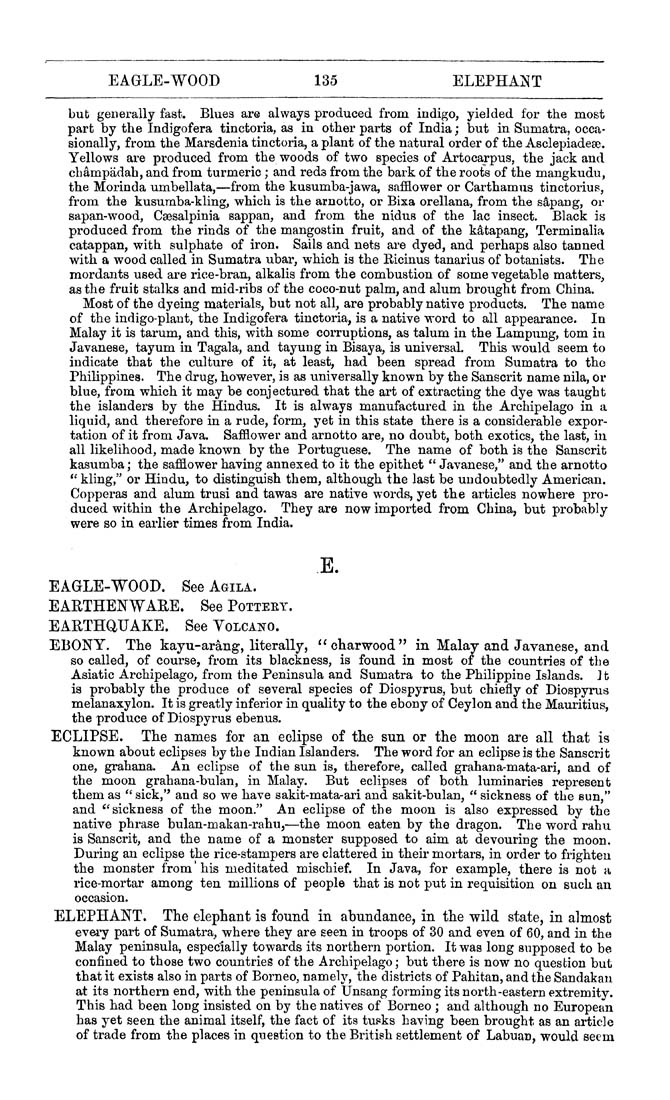EAGLE-WOOD 135 ELEPHANT
but generally fast. Blues ar© always produced from indigo, yielded for the most
part by the Indigofera tinctoria, as in other parts of India; but in Sumatra, occa¬
sionally, from the Marsdenia tinctoria, a plant of the natural order of the Asclepiadese.
Yellows are produced from the woods of two species of Artocarpus, the jack and
champadah, and from turmeric ; and reds from the bark of the roots of the mangkudu,
the Morinda umbellata,—from the kusumba-jawa, safflower or Carthamus tinctorius,
from the kusumba-kling, which is the arnotto, or Bixa orellana, from the s^pang, or
sapan-wood, Ca3salpinia sappan, and from the nidus of the lac insect. Black is
produced from the rinds of the mangostin fruit, and of the k^tapang, Terminalia
catappan, with sulphate of iron. Sails and nets are dyed, and perhaps also tanned
with a wood called in Sumatra ubar, which is the Ricinus tanarius of botanists. The
mordants used are rice-bran, alkalis from the combustion of some vegetable matters,
as the fruit stalks and mid-ribs of the coco-nut palm, and alum brought from China.
Most of the dyeing materials, but not all, are probably native products. The name
of the indigo-plant, the Indigofera tinctoria, is a native word to all appearance. In
Malay it is tarum, and this, with some corruptions, as talum in the Lampung, tom in
Javanese, tayum in Tagala, and tayung in Bisaya, is universal. This would seem to
indicate that the culture of it, at least, had been spread from Sumatra to the
Philippines. The drug, however, is as universally known by the Sanscrit name nila, or
blue, from which it may be conjectured that the art of extracting the dye was taught
the islanders by the Hindus. It is always manufactured in the Archipelago in a
liquid, and therefore in a rude, form, yet in this state there is a considerable expor¬
tation of it from Java. Safflower and arnotto are, no doubt, both exotics, the last, in
all likelihood, made known by the Portuguese. The name of both is the Sanscrit
kasumba; the safflower having annexed to it the epithet " Javanese," and the arnotto
" kling," or Hindu, to distinguish them, although the last be undoubtedly American.
Copperas and alum trusi and tawas are native words, yet the articles nowhere pro¬
duced within the Archipelago. They are now imported from China, but probably
were so in earlier times from India.
E.
EAGLE-WOOD. See Agila.
EARTHENWARE. See Potteey.
EARTHQUAKE. See Volcai^o.
EBONY. The kayu-arang, literally, ^'charwood" in Malay and Javanese, and
so called, of course, from its blackness, is found in most of the countries of the
Asiatic Archipelago, from the Peninsula and Sumatra to the Philippine Islands. 11
is probably the produce of several species of Diospyrus, but chiefly of Diospyrus
melanaxylon. It is greatly inferior in quality to the ebony of Ceylon and the Mauritius,
the produce of Diospyrus ebenus.
ECLIPSE. The names for an eclipse of the sun or the moon are all that is
known about eclipses by the Indian Islanders. The word for an eclipse is the Sanscrit
one, grahana. An eclipse of the sun is, therefore, called grahana-mata-ari, and of
the moon grahana-bulan, in Malay. But eclipses of both luminaries represent
them as ''sick," and so we have sakit-mata-ari and sakit-bulan, " sickness of the sun,"
and ^'sickness of the moon." An eclipse of the moon is also expressed by the
native phrase bulan-makan-rahu,—the moon eaten by the dragon. The word rahu
is Sanscrit, and the name of a monster supposed to aim at devouring the moon.
During an eclipse the rice-stampers are clattered in their mortars, in order to frighten
the monster from' his meditated mischief. In Java, for example, there is not a
rice-mortar among ten millions of people that is not put in requisition on such an
occasion.
ELEPHANT. The elephant is found in abundance, in the wild state, in almost
eveiy part of Sumatra, where they are seen in troops of 30 and even of 60, and in the
Malay peninsula, especially towards its northern portion. It was long supposed to be
confined to those two countries of the Archipelago; but there is now no question but
that it exists also in parts of Borneo, namely, the districts of Pahitan, and the Sandakan
at its northern end, with the peninsula of Unsang forming its north-eastern extremity.
This had been long insisted on by the natives of Borneo ; and although no European
has yet seen the animal itself, the fact of its tusks having been brought as an article
of trade from the places in question to the British settlement of Labuan, would seem
|








